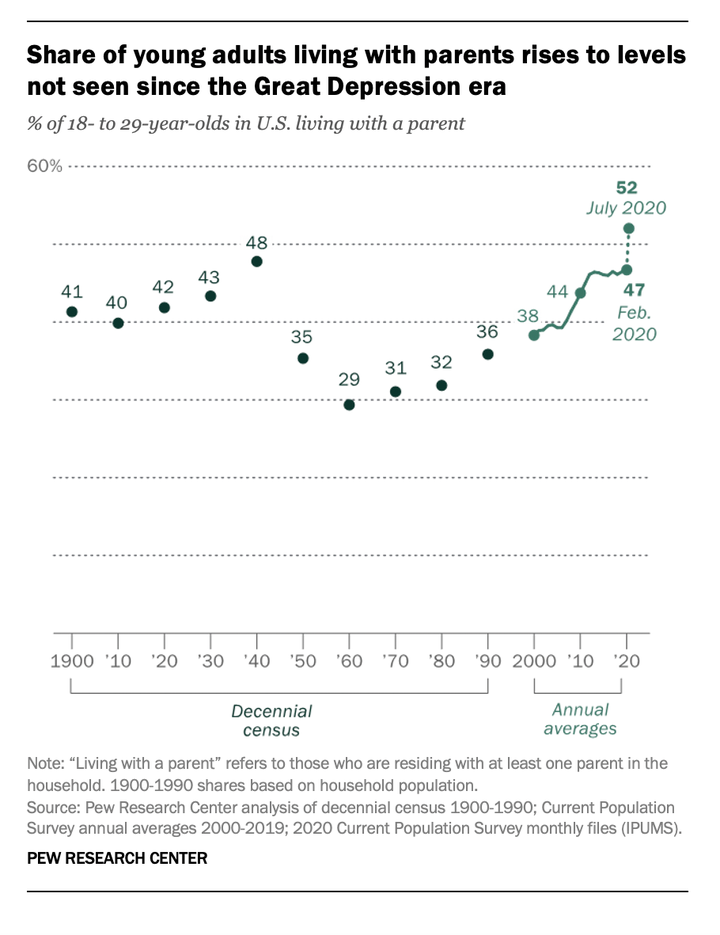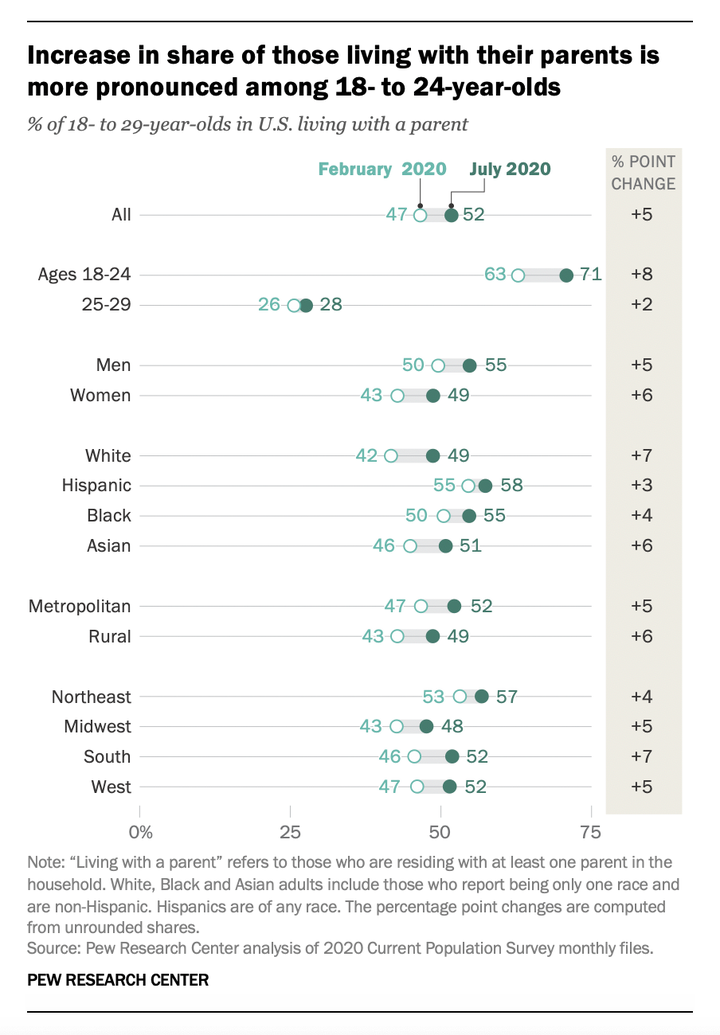The number of young adults living with their parents hit at least an eight-decade high in July, as the pandemic’s disruption of jobs hit young generations particularly hard.
More than half of adults under 30 (52%), or 26.6 million, are living with one or both of their parents as of July, according to a study from Pew Research Center. That’s up from 47% in February and exceeds the previous high of 48% in 1940, according to Census data.
It’s also the highest recorded level from the Census dating back to 1900, but no data is available from the Great Depression, which likely was worse, according to Pew.
The increase is part of an upward trend since the 1960s, but the coronavirus distorted that trajectory after states implemented shutdowns and companies laid off workers or moved to remote work. But the effects could take awhile to wane.
“For the most part, nobody wants to be living at home with mom and dad,” said Jeremy Sopko, CEO of Nations Lending Corporation, a mortgage lender. “It’s a difficult situation that’s been exacerbated by the pandemic and it may take years, if not the better part of a decade, for younger demographics to recover and be financially stable enough to leave home.”

‘Slew of factors working against the younger demographics’
Growth was sharpest for those between 18 and 24, which increased from 63% living at home in February to 71% in July. The number of households headed by an 18- to 19-year-olds declined by 1.9 million, or 12%, between February and July 2020.
Notably, the change is not because of college closures in the spring. The Census data already considers unmarried students who live in campus dorms as living in the family home.
But the rapid rise in unemployment does correlate with the increase in young people living at home, according to Pew. The percentage share of 16- to 24-year-olds who are neither in school or employed increased more than two-fold to 28% in June from February, when it was 11%.

“Unfortunately you’ve got a slew of factors working against the younger demographics in this country right now,” Sopko said. “You have to take into account two huge factors: massive student loan debt and a lack of available work, especially in service fields, hospitality, and the travel sectors.”
Similarly, 18- to 24-year-olds had the highest unemployment rates in July than any other age groups. The rate was 19.8% for 18- to 19-year-olds, after spiking to 34.3% in April. It was slightly lower at 18.3% in July for 20- to 24-year-olds, following a jump to 25.7% in April, according to the Bureau of Labor Statistics.
‘Large increase in non-Hispanic white young adults’
But unemployment only explains part of the increase in living at home.
“The relatively large increase in non-Hispanic white young adults living with parents compared with young adults of other racial and ethnic backgrounds was unexpected,” said Richard Fry, senior researcher of the study at Pew Research Center. “Earlier Pew research shows that the job losses associated with the pandemic were less severe for whites.”
Historically, white young adults were less likely to live with their parents than Asian, Black and Hispanic young people. But Pew found that gap has shrunk since February as white young adults moved back home at a faster rate than their Asian, Black, and Hispanic counterparts. White Americans accounted for more than two-thirds of the increase.

The move back home could be more of a lifestyle choice during the pandemic for some young adults, rather than a financial necessity after a job loss, said Brent Cohen, executive director of Generation Progress, a research and advocacy center for young people.
“For those who were working remotely, this was likely a short-term move so that they weren’t alone in their apartments when social distancing measures were put in place,” Cohen said. “But, what was expected by many to last two to four weeks, has now extended for nearly six months.”
While all regions saw increases in young people living with their parents, the South experienced the largest jump from February to July. Rural and metropolitan areas saw similar change in living arrangements among young adults.
“This underscores the wide reach of the pandemic geographically,” Fry said.
As the virus spreads and communities work to contain it by restricting many activities, the speed of recovery of the U.S. labor market remains uncertain, Fry said.
“It is hard to know if living with parents has peaked,” he said.
Read more:
'Not a rent holiday:' Trump's new eviction action leaves renters on the hook for months of backpay
Coronavirus: Trump administration attempts to prevent evictions using CDC quarantine authority
Coronavirus stimulus: No action yet on Trump's executive order on evictions
President Trump's promises to prevent evictions offers ‘false hope,’ experts say
Read the latest financial and business news from Yahoo Finance and Yahoo Money
Follow Yahoo Finance on Twitter, Facebook, Instagram, Flipboard, SmartNews, LinkedIn, YouTube, and reddit.

